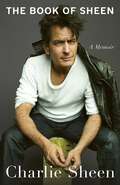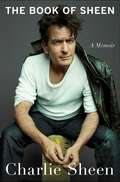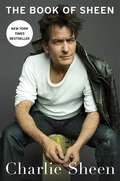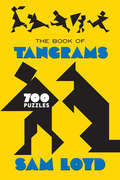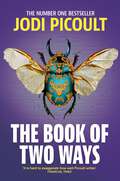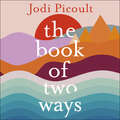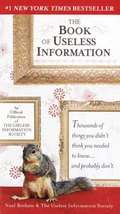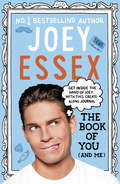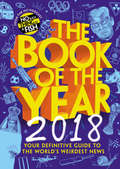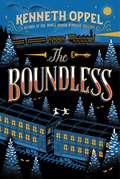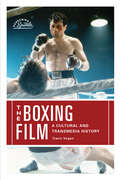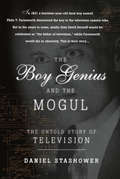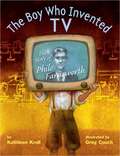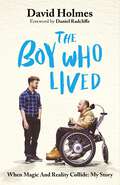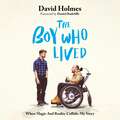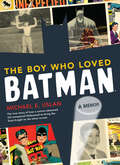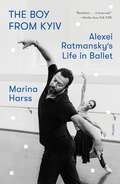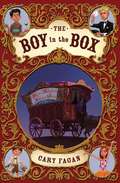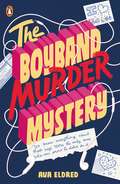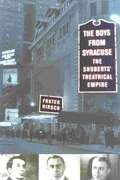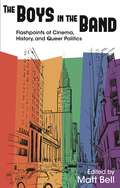- Table View
- List View
The Book of Sheen
by Charlie SheenFor the first time, Charlie Sheen – the star of Platoon, Wall Street, Major League and Two and a Half Men – writes the story of his extraordinary life in an unfiltered memoir.&‘We can live the stories or hear about them later from others. I choose the former.&’Charlie Sheen shouldn&’t be alive to write this book. But in The Book of Sheen, the movie and TV star, who has defied the odds, finally presents his story, in his own words. Charlie Sheen was born the third of four children to actor Martin Sheen and his wife, Janet. He grew up on film sets – from his father&’s all over the world, to his own in Malibu. There, he made ambitious Super 8s, with a roster of friends who went on to become household names, including his brother Emilio, Sean and Chris Penn and the Lowe brothers.Sheen broke into movies in the 1980s, playing a hoodlum in Ferris Bueller&’s Day Off, a young soldier in Platoon and an ethically compromised trader in Wall Street. But somewhere along the way, despite a successful transition to TV leading man in Spin City and Two and a Half Men, Sheen descended into a vortex of extracurricular activities.Now sober, Sheen delivers a clear-eyed narrative of his highs and lows with humour, candour and a vivid, captivating writing style that is uniquely his. The Book of Sheen reads like a far-fetched, overstuffed novel of Hollywood life – yet it is all true.
The Book of Sheen
by Charlie Sheen"We can live the stories or hear about them later from others. I choose the former." <P><P> Charlie Sheen should not be alive to tell these stories. But in The Book of Sheen, the star who has defied all odds – decades of addiction (to drugs, alcohol, gambling, and more), an HIV diagnosis, three divorces, a dust-up with the Sinaloan cartel, and other challenges that will leave readers stunned – finally presents the truth... or, at least his version. ("The facts are the facts; how I choose to interpret or deconstruct them falls squarely on me," Sheen writes.) <P><P> From his childhood spent on movie sets for blockbusters like Apocalypse Now; to the golden days of 1980s Hollywood, filled with heartthrobs like Rob Lowe and Sean Penn; to the humid jungles of the Philippines and mock-army training that crossed dangerously into life-threatening for the filming of Platoon; to the early aughts' sitcom dominance, every Sheen anecdote drips with shocking lucidity, humor, and self-deprecation. Sheen deftly leads readers through his childhood as the son of award-winning actor Martin Sheen (a "Cathoholic"), which took the family from New York to Mexico to Italy and beyond; his competitive brotherhood against fellow teen heartthrob and Brat Pack member Emilio Estevez; his debilitating stutter that continued into adulthood and which he attempted to hide from producers and directors; his friendships with Chris and Sean Penn, Rob Lowe, Nic Cage, Matthew Perry, and other troubled stars of the era; his adventures on and off camera for films like Platoon and Wall Street and shows like Spin City and Two and a Half Men; his challenges in fatherhood and the kids that ultimately got him sober; and more. Woven throughout is a constant: addiction, and Sheen's perpetual battle with it. <P><P> Riddled with regrets, filled with humor, and finally candid, Sheen delivers a truly hilarious no-holds-barred memoir, one fitting for a star of his caliber and controversy. <P><P> <B>New York Times Bestseller</B>
The Book of Sheen: A Memoir
by Charlie SheenFor the first time, Charlie Sheen, the star of Platoon, Wall Street, Major League, and Two and a Half Men, writes the story of his extraordinary life in an unfiltered memoir.&“We can live the stories or hear about them later from others. I choose the former.&”Charlie Sheen should not be alive to write this book.But in The Book of Sheen, the movie and TV star, who has defied the odds, finally presents his story, in his own words.Charlie Sheen was born the third of four children to actor Martin Sheen and his wife, Janet. He grew up on film sets—from his father&’s all over the world, to his own in Malibu. There he made ambitious Super 8s, with a roster of friends who went on to become household names themselves, including his brother Emilio, Sean and Chris Penn, and the Lowe brothers.Sheen broke into movies in the 1980s, playing a hoodlum in Ferris Bueller&’s Day Off, a young soldier in Platoon, and an ethically compromised trader in Wall Street. But somewhere along the way, despite a successful transition to TV leading man in Spin City and Two and a Half Men, Sheen descended into a vortex of extracurricular activities.Now sober, Sheen delivers a clear-eyed narrative of his highs and lows with humor, candor, and a vivid, captivating writing style that is uniquely his. The Book of Sheen reads like a far-fetched, overstuffed novel of Hollywood life—yet it is all true.
The Book of Tangrams: 700 Puzzles
by Sam LoydThe challenge of the tangram, the original "Chinese puzzle," lies in your ability to arrange seven geometrical pieces — a square, a rhomboid, and five triangles — into a variety of different shapes. Collected by Sam Loyd, America's great puzzle expert, these 700 endlessly absorbing tangrams offer hours of mind-expanding amusement. Sam Loyd's The Book of Tangrams is also a tribute to this tricky and intriguing puzzle. In a famous and delightful spoof of the tangram's history, Loyd includes running commentary on the popular puzzle's origins in ancient China, its religious significance, and its relation to the Pythagorean theorem. But don't let the amusing dialogue fool you! The puzzles are genuine challenges. If you've ever tried your hand at tangrams before, you're probably already addicted to their limitless possibilities. If you haven't, this classic puzzle potpourri will have you hooked in no time! Solutions are included.
The Book of Two Ways: A Novel
by Jodi PicoultOrder Jodi Picoult's stunning new novel about life, death, and missed opportunities. THE #1 NEW YORK TIMES BESTSELLER'A writer the world should be reading right now.' IndependentWho would you be, if you hadn't turned out to be the person you are now? Dawn is a death doula, and spends her life helping people make the final transition peacefully. But when the plane she's on plummets, she finds herself thinking not of the perfect life she has, but the life she was forced to abandon fifteen years ago - when she left behind a career in Egyptology, and a man she loved. Against the odds, she survives, and the airline offers her a ticket to wherever she needs to get to - but the answer to that question suddenly seems uncertain. As the path of her life forks in two very different directions, Dawn must confront questions she's never truly asked: what does a well-lived life look like? What do we leave behind when we go? And do we make our choices, or do our choices make us?Two possible futures. One impossible choice. ----------------------------------------------------------------'It is hard to exaggerate how well Picoult writes.' Financial Times 'A matchless talent for hitting emotional notes.' Irish Times'A wise, cerebral, propulsive adventure . . . eruditely spans the worlds of Egyptology, university physics and end-of-life care, while never losing sight of its high-stakes human story . . . a captivatingly immersive, multilayered, painstakingly researched and impressively realised exploration of deeply human geographies.' The Sunday Times'This complex, time-shifting romance combines moral hazard with Wuthering Heights echoes and degree-level Egyptology. And there aren't many books you can say that about.' Daily Mail
The Book of Two Ways: The stunning bestseller about life, death and missed opportunities
by Jodi PicoultDawn thinks she knows everything there is to know about dying. As a death doula she helps her clients fix what is left undone so they can peacefully make the final transition. But when her plane plummets from the sky and she thinks she is experiencing the last moments of her life, she is shocked to find that she isn't thinking of her husband or teenage daughter - but of a road she strayed from 15 years earlier, when she turned her back on her PhD studies. Against all odds, Dawn survives, and the airline gives her a free ticket to wherever she needs to get to. in alternating chapters, we see possible choices: Land - returning to her husband, a quantum physicist who studies the possibilities of parallel universes, she is faced with a test to her marriage and a daughter who is struggling with self-image issues. And Water: returning to her studies and the archaeological site she worked on 15 years earlier, where the man she abandoned is about to make the discovery of a lifetime. But time may not be as straightforward as we think. As Dawn explores her possible futures, she is finding out what a well-lived life means, what we leave behind of ourselves when we leave the earth, and who she might have been...(P) 2020 Penguin Random House Audio
The Book of Useless Information
by Noel BothamThousands of things you didn't think you needed to know--and probably don't. All you never needed to know, and couldn't be bothered to ask. One person's useless information could prove invaluable to someone else. Then again, maybe not. But to The Useless Information Society, any fact that passes its gasp-inducing, "not-a-lot-of-people-know-that" test merits inclusion in this fascinating but ultimately useless book. Did you know... - That fish scales are used to make lipstick? - Why organized crime accounts for ten percent of the United States's annual income? - The name of the first CD pressed in the U.S.? - The shortest performance ever nominated for an Oscar? - How much Elvis weighed at the time of his death? - What the suits in a deck of cards represent? - How many Quarter Pounders can be made from one cow? - How interesting useless information can be? The Book of Useless Information answers these teasers and will captivate readers with the joy of pursuing pointless knowledge.
The Book of You (and Me)
by Joey EssexHello You, Do you know what you're holding in your hands? It's a book (sort of) that I've made for you (and me) to co-create and finish together. And since we're counting, YES it's the second one I've written. BOOM. Let's celebrate everything that makes us unique with this mixture of creative and interactive activities resulting in your own REEM masterpiece! Have you ever wanted to take a selfie with your postman? Well now's your chance. Or have you ever wondered what came first, the chicken or the egg? Well I'll tell you! Basically ignore everything you've ever been told about what NOT to do to books: scribble, make up new words, draw pictures of your daily outfits and go on a Joey treasure hunt. This is truly the best of collaborations - between you... And, Me x
The Book of the Year 2018: Your Definitive Guide to the World’s Weirdest News
by No Such Thing As A Fish__________‘My favourite geeks. Hilarious. Sideways. Brilliant.’ Tim MinchinIn a year dominated by Russian collusion and Brexit confusion, The Book of the Year returns with another dose of barely believable yet wholly unimpeachable facts and stories from the past twelve months. Every week for the past four years, Dan, James, Anna and Andy – the creators of the award-winning, chart-topping comedy podcast No Such Thing As A Fish – have wowed each other and millions of their listeners with the most astonishing trivia they have learned over the previous seven days. Now, once again, they have put down the microphones, picked up their pencils, and transformed a year’s worth of weird and wonderful happenings into one uplifting book that you won’t be able to put down. Discover how Peruvian mummies affected the World Cup, and why Love Island contestants are experts in game theory – as well as hundreds of stories that may have passed you by entirely, including the news that:· NASA sent a man with a fear of heights to the International Space Station. · An ice hotel in Canada caught fire. · Mark Zuckerberg’s private data was compromised while he was talking to Congress about compromised data. From Kim Jong Un’s personal potty to Jeremy Corbyn’s valuable vegetables, The Book of the Year 2018 is an eye-opening tour of yet another incredible year you didn’t know you’d lived through.
The Bootlace Magician
by Cassie BeasleyWelcome back to Circus Mirandus . . . a place with magic so wondrous, you need to believe it to see it.Micah Tuttle--magician in training--lives and works at Circus Mirandus alongside his guardian, the ancient and powerful Lightbender. The circus is a place filled with dazzling fire shows, stubborn unicorns, and magicians from every corner of the world. And Micah is doing everything he can to prove he belongs there. When a dangerous enemy from the past threatens his new home, Micah will have to untangle the mystery of his own potent magic, and he'll have to do it fast. With trouble this deadly on its way, every magician will need to be ready to fight. Even the youngest.
The Boswell Legacy
by Kyla Titus David McCain Chica Boswell MinnerlyThe Boswell Sisters rose to stardom during the Great Depression and established an enormously successful career in a very short time as pioneers of early mass entertainment, through the new media of electrical recordings, radio networks, and movies. Along with Louis Armstrong and Duke Ellington, they led an American jazz "invasion" of Europe in 1933. They were admired by their frequent singing partner Bing Crosby, idolized by a struggling trio from Minneapolis who later gained fame as the Andrews Sisters, and praised as "the best act I ever followed" by a trouper named Bob Hope. Ella Fitzgerald consistently credited Connie Boswell as her main influence and Irving Berlin singled her out as his favorite interpreter of his songs. The beautiful and talented Boswells sold out stage shows from New York to London and the number of records they sold is estimated to be over 75 million. Then suddenly, it was over. The time has finally come to tell their story. THE BOSWELL LEGACY is the first full-scale biography of these icons of American music, written by Kyla Titus, the granddaughter of Vet Boswell and caretaker of the voluminous Boswell family archives, as only she can tell it. Within these pages, readers may discover the answers to questions left unanswered for decades. Why did the Boswell Sisters disband? What was the cause of Connie’s paralysis? Why are the Boswell Sisters not household names today? And so many more. Most importantly, readers will learn about the development of a unique musical style that is timeless--a legacy--that is still heralded almost a century later.
The Boundless
by Kenneth Oppel Jim TierneyThe Boundless, the greatest train ever built, is on its maiden voyage across the country, and first-class passenger Will Everett is about to embark on the adventure of his life! <p><p> When Will ends up in possession of the key to a train car containing priceless treasures, he becomes the target of sinister figures from his past. <p><p> In order to survive, Will must join a traveling circus, enlisting the aid of Mr. Dorian, the ringmaster and leader of the troupe, and Maren, a girl his age who is an expert escape artist. With villains fast on their heels, can Will and Maren reach Will’s father and save The Boundless before someone winds up dead?
The Boxing Film: A Cultural and Transmedia History (Screening Sports)
by Travis VoganAs one of popular culture’s most popular arenas, sports are often the subject of cinematic storytelling. But boxing films are special. There are more movies about boxing, by a healthy margin, than any other sport, and boxing accompanied and aided the medium’s late 19th century emergence as a popular mass entertainment. Many of cinema’s most celebrated directors—from Oscar Micheaux to Martin Scorsese—made boxing films. And while the production of other types of sports movies generally corresponds with the current popularity of their subject, boxing films continue to be made regularly even after the sport has wilted from its once prominent position in the sports hierarchy of the United States. From Edison’s Leonard-Cushing Fight to The Joe Louis Story, Rocky and beyond, this book explores why boxing has so consistently fascinated cinema, and popular media culture more generally, by tracing how boxing movies inform the sport’s meanings and uses from the late 19th century to the early 21st century.
The Boy Genius and the Mogul: The Untold Story of Television
by Daniel StashowerThe world remembers Edison, Ford, and the Wright Brothers. But what about Philo T. Farnsworth, the inventor of television, an innovation that did as much as any other to shape the twentieth century? That question lies at the heart ofThe Boy Genius and the Mogul, Daniel Stashower's captivating chronicle of television's true inventor, the battle he faced to capitalize on his breakthrough, and the powerful forces that resulted in the collapse of his dreams. The son of a Mormon farmer, Farnsworth was bor...
The Boy Who Invented TV: The Story of Philo Farnsworth
by Kathleen KrullAn inspiring true story of a boy genius. Plowing a potato field in 1920, a 14-year-old farm boy from Idaho saw in the parallel rows of overturned earth a way to "make pictures fly through the air." This boy was not a magician; he was a scientific genius and just eight years later he made his brainstorm in the potato field a reality by transmitting the world's first television image. This fascinating picture-book biography of Philo Farnsworth covers his early interest in machines and electricity, leading up to how he put it all together in one of the greatest inventions of the 20th century. The author's afterword discusses the lawsuit Farnsworth waged and won against RCA when his high school science teacher testified that Philo's invention of television was years before RCA's.
The Boy Who Lived: When Magic and Reality Collide: my story, with a foreword by Daniel Radcliffe
by David HolmesTHE POWERFUL MEMOIR FROM HARRY POTTER STUNTMAN DAVID HOLMES, WITH A FOREWORD BY DANIEL RADCLIFFE: AVAILABLE TO PRE-ORDER NOW! As stunt double to Daniel Radcliffe in the Harry Potter film franchise, stuntman David Holmes helped to move J.K. Rowling's era-defining story from the page to the big screen. His work as a real-life Fall Guy enabled him to create some of the most memorable action sequences in the Wizarding World, as he became the first person ever to play Quidditch. In living his own hero's journey, David was also one of only a handful of people to have worn the iconic wizard's cape, glasses and scar in front of the cameras.That is, until an accident changed his life forever.During the making of Harry Potter and the Deathly Hallows: Part 1, David broke his neck in a stunt rehearsal and was instantly paralysed. From talented junior gymnast and stunt prodigy to fully qualified Hollywood stuntman, his story is a brutally honest portrait of a man who lost everything but found different ways to reimagine new possibilities with love, friendship and optimism - and he later co-created a BAFTA-nominated documentary about his life. David's behind-the-scenes look at one of the biggest film series of all time is both jaw-dropping and hilarious.Powerful and emotional, his is a story of hope and vulnerability and paints a picture of what it truly takes to rebuild a life and become The Boy Who Lived.
The Boy Who Lived: When Magic and Reality Collide: my story, with a foreword by Daniel Radcliffe
by David HolmesTHE INSPIRATIONAL MEMOIR FROM HARRY POTTER STUNTMAN DAVID HOLMES, WITH A FOREWORD BY DANIEL RADCLIFFE: PERFECT FOR HARRY POTTER FANS As stunt double to Daniel Radcliffe in the Harry Potter film franchise, stuntman David Holmes helped to move J.K. Rowling's era-defining story from the page to the big screen. His work as a real-life Fall Guy enabled him to create some of the most memorable action sequences in the Wizarding World, as he became the first person ever to play Quidditch. In living his own hero's journey, David was also one of only a handful of people to have worn the iconic wizard's cape, glasses and scar in front of the cameras.That is, until an accident changed his life forever.During the making of Harry Potter and the Deathly Hallows: Part 1, David broke his neck in a stunt rehearsal and was instantly paralysed. From talented junior gymnast and stunt prodigy to fully qualified Hollywood stuntman, his story is a brutally honest portrait of a man who lost everything but found different ways to reimagine new possibilities with love, friendship and optimism - and he later co-created a BAFTA-nominated documentary about his life. David's behind-the-scenes look at one of the biggest film series of all time is both jaw-dropping and hilarious.Powerful and emotional, his is a story of hope and vulnerability and paints a picture of what it truly takes to rebuild a life and become The Boy Who Lived. --------------'Brutally honest, utterly engaging, deeply sad yet incredibly uplifting. A must-read.' ⭐⭐⭐⭐⭐ 'A million stars for this incredible book.' ⭐⭐⭐⭐⭐ 'A beautifully authentic story and I'm a better person for having read it.' ⭐⭐⭐⭐⭐ 'I'm not normally a reader, but I managed to finish this book in two days. A spectacular piece of writing!'⭐⭐⭐⭐⭐
The Boy Who Lived: When Magic and Reality Collide: my story, with a foreword by Daniel Radcliffe
by David HolmesTHE INSPIRATIONAL MEMOIR FROM HARRY POTTER STUNTMAN DAVID HOLMES: PERFECT FOR HARRY POTTER FANS.NARRATED BY THE AUTHOR, WITH A FOREWORD BY DANIEL RADCLIFFE NARRATED BY TOBY LAURENCE.As stunt double to Daniel Radcliffe in the Harry Potter film franchise, stuntman David Holmes helped to move J.K. Rowling's era-defining story from the page to the big screen. His work as a real-life Fall Guy enabled him to create some of the most memorable action sequences in the Wizarding World, as he became the first person ever to play Quidditch. In living his own hero's journey, David was also one of only a handful of people to have worn the iconic wizard's cape, glasses and scar in front of the cameras.That is, until an accident changed his life forever.During the making of Harry Potter and the Deathly Hallows: Part 1, David broke his neck in a stunt rehearsal and was instantly paralysed. From talented junior gymnast and stunt prodigy to fully qualified Hollywood stuntman, his story is a brutally honest portrait of a man who lost everything but found different ways to reimagine new possibilities with love, friendship and optimism - and he later co-created a BAFTA-nominated documentary about his life. David's behind-the-scenes look at one of the biggest film series of all time is both jaw-dropping and hilarious.Powerful and emotional, his is a story of hope and vulnerability and paints a picture of what it truly takes to rebuild a life and become The Boy Who Lived.
The Boy Who Loved Batman: A Memoir
by Michael E. UslanThe Batman movie producer reveals how his childhood love of comic books became a lifelong passion and dream job in this illustrated memoir.Is any superhero cooler than Batman? He’s a crime-fighting vigilante with a tragic past, a lawless attitude, and a seemingly endless supply of high-tech gadgetry. In this fully illustrated memoir, author Michael Uslan recalls his journey from early childhood fandom through to the decades he spent on a caped crusade of his own: to bring Batman to the silver screen as the dark, serious character he was at heart. Uslan’s story traces his path from the wilds of New Jersey to the limelight of Hollywood, following his work as Executive Producer on every Batman film from Tim Burton’s 1989 re-envisioning to 2012’s The Dark Knight Rises. Through it all, he helped to create one of the most successful pop culture franchises of all time.“Don’t miss this spellbinding tale of one man who saw what Batman was—and realized what he could become.” —Stan Lee
The Boy from Kyiv: Alexei Ratmansky's Life in Ballet
by Marina HarssNamed a Best Book of the Year by NPR and The New YorkerThe Boy from Kyiv is the life story of Alexei Ratmansky, the most celebrated ballet choreographer of our time.“A revelatory book about how [Ratmansky] evolved into the internationally sought-after choreographer of the moment . . . A must-read.” — Martha Anne Toll, NPRAlexei Ratmansky is transforming ballet for the twenty-first century. An artist of daring imagination, the choreographer has created breathtakingly original works for the world’s most revered companies. He has fashioned a singular approach to balletic storytelling that bridges the space between narrative and abstraction and heightens ambiguity and surprise on the stage. He has boldly restored great centuries-old ballets to their former glory, combining archival research with his own choreographic genius to retrieve detail and color once lost to the ages. And above all, he is renowned for fusing the Western and Eastern ballet traditions, and for drawing on the visual arts, literature, music, film, and beyond with inspired vim, to forge a style that is vibrant, eclectic, and utterly new: one that promises to leave an indelible mark on this venerable art form.But before Ratmansky was the artistic director of the Bolshoi Ballet, the resident choreographer at American Ballet Theatre, the artist in residence at New York City Ballet, and generally, as The New Yorker has it, “the most sought-after man in ballet,” he was just a boy from Kyiv, sneaking into the ballet at night, concocting his own juvenile adaptations of novels and stories, and dreaming up new possibilities for bodies in motion.In The Boy from Kyiv, the first biography of this groundbreaking artist, the celebrated dance writer Marina Harss takes us behind the curtain to reveal Ratmansky’s fascinating life, from his Soviet boyhood through his globe-spanning career. Over a decade in the making, this biography arrives at a pivotal moment in Ratmansky’s journey, one that has seen him painfully and publicly break ties with Russia, the country in which he made his name, in solidarity with his native Ukraine, and take on a new challenge at the storied New York City Ballet. Told with the lyricism, drama, and verve that befit its subject, The Boy from Kyiv is a riveting account of this major artist’s ascent to the peaks of his field, a mesmerizing study of creativity in action, and a triumphant testament to ballet’s enduring vitality.
The Boy in the Box
by Cary Fagan"If you always feel fully and completely happy, my friends, then you do not need my drops and I will not sell them to you for any amount of money." --Master Melville Eleven-year-old juggling enthusiast Sullivan Mintz helps his family run the Stardust Home for Old People. It's not ideal: his best friend, Manny, is eighty-one years old. But life as usual turns upside down when Master Melville's Medicine Show comes to town. Sullivan's excitement at finding performers his own age dissolves into dread when he steps onstage for a magic act only to wake up imprisoned in the traveling show's caravan. As his fears subside, his questions multiply. Is his family better off without him? Would life as a juggler performing with other kids be worse than living in an old folks' home? Being kidnapped could be the best thing that ever happened to him . . . or decidedly not.
The Boyband Murder Mystery
by Ava Eldred'I have long believed that loving a boyband brings with it a wealth of transferable skills, but I'd never imagined solving a murder would be one of them...'Harri and her best friends worship Half Light - an internationally famous boyband. When frontman Frankie is arrested on suspicion of murdering his oldest friend Evan, Harri feels like her world's about to fall apart. But quickly she realises that she - and all the other Half Light superfans out there - know and understand much more about these boys than any detective ever could.Now she's rallying a fangirl army to prove Frankie's innocence - and to show the world that you should never underestimate a teenage girl with a passion...
The Boys and Me: My Life in the Country Music Supergroup Sawyer Brown
by Mark MillerThe Boys and Me is the behind-the-scenes, untold story of front man and lead singer Mark Miller and his band—country music icons Sawyer Brown!Before The Voice and American Idol, there was Star Search with Ed McMahon. In the first season, an eclectic and charismatic country-rock band called Sawyer Brown appeared on the show, taking America by storm. From ignored underdogs in Nashville to overnight rock stars from LA to New York, they swept the competition and won. Since 1984, &“the boys&” legendary live shows, along with their relentless drive to stay true to themselves, have captivated faithful fans around the world. As front man and lead singer of the band, Mark Miller&’s rise to fame wasn&’t exactly the path he envisioned for himself. After losing his father, Mark was raised by his mom whose solid faith and strong work ethic helped guide and shape him and his brother, Frank. With his sights set on playing pro basketball, Mark never dreamed of becoming an entertainer, especially considering he was terrified to stand on a stage. But God had a different plan. Now, forty years later, Sawyer Brown has eighteen studio albums to their name, multiple No. 1 singles, fifty-plus songs charting on the Billboard Hot Country Songs, and legendary award-winning videos. And they have no plans of stopping any time soon. The band&’s longevity is a testament to their strong songwriting, high-energy performances, and hard work. This is the behind-the-scenes, untold story of Mark Miller and &“the boys&”—country music icons Sawyer Brown!
The Boys from Syracuse: The Shuberts' Theatrical Empire
by Foster HirschFrom 1905 to the crash of 1929, Sam Shubert (1874-1905) and his brothers Lee (1874-1953) and J. J. (1878-1963), despite poor beginnings and near-illiteracy, created a theater monopoly unrivaled in history. Their ruthless business tactics and showmanship made 42nd Street the heart of American popular theater and won them the most sought-after stars of the day, including Al Jolson, Carmen Miranda, Eddie Cantor, Fanny Brice, Mae West, and Fred Astaire.
The Boys in the Band: Flashpoints of Cinema, History, and Queer Politics
by Matt BellThe Boys in the Band’s debut was revolutionary for its fictional but frank presentation of a male homosexual subculture in Manhattan. Based on Mart Crowley’s hit Off-Broadway play from 1968, the film’s two-hour running time approximates real time, unfolding at a birthday party attended by nine men whose language, clothing, and behavior evoke a range of urban gay “types.” Although various popular critics, historians, and film scholars over the years have offered cursory acknowledgment of the film’s importance, more substantive research and analysis have been woefully lacking. The film’s neglect among academics belies a rich and rewarding object of study. The Boys in the Band merits not only the close reading that should accompany such a well-made text but also recognition as a landmark almost ideally situated to orient us amid the highly complex, shifting cultural terrain it occupied upon its release—and has occupied since. The scholars assembled here bring an invigorating variety of methods to their considerations of this singular film. Coming from a wide range of academic disciplines, they pose and answer questions about the film in remarkably different ways. Cultural analysis, archival research, interviews, study of film traditions, and theoretical framing intensify their revelatory readings of the film. Many of the essays take inventive approaches to longstanding debates about identity politics, and together they engage with current academic work across a variety of fields that include queer theory, film theory, gender studies, race and ethnic studies, and Marxist theory. Addressing The Boys in the Band from multiple perspectives, these essays identify and draw out the film’s latent flashpoints—aspects of the film that express the historical, cinematic, and queer-political crises not only of its own time, but also of today. The Boys in the Band is an accessible touchstone text in both queer studies and film studies. Scholars and students working in the disciplines of film studies, queer studies, history, theater, and sociology will surely find the book invaluable and a shaping influence on these fields in the coming years.
